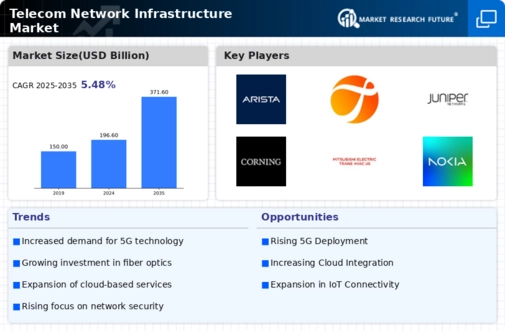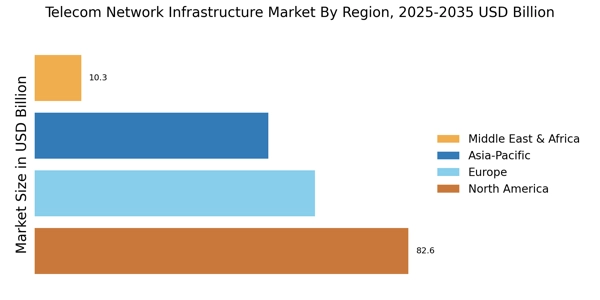Emergence of Smart Cities
The emergence of smart cities is a transformative trend impacting the Telecom Network Infrastructure Market. As urban areas evolve into smart cities, the demand for advanced telecommunications infrastructure becomes critical. Smart city initiatives often involve the integration of various technologies, including smart grids, intelligent transportation systems, and enhanced public safety measures, all of which require robust network capabilities. The smart city market is projected to grow to over 1 trillion USD by 2025, driving significant investments in telecom infrastructure. Consequently, telecom operators are likely to enhance their networks to support the diverse applications and services that smart cities demand, thereby fostering growth in the Telecom Network Infrastructure Market.
Expansion of Internet of Things (IoT)
The expansion of the Internet of Things (IoT) is significantly influencing the Telecom Network Infrastructure Market. With billions of devices expected to be connected to the internet, the need for robust and scalable network infrastructure becomes paramount. The IoT market is projected to grow to over 1.5 trillion USD by 2025, necessitating telecom operators to enhance their network capabilities. This growth drives the demand for advanced infrastructure solutions that can handle the increased data traffic and connectivity requirements. As a result, telecom companies are likely to invest in next-generation technologies, such as edge computing and network slicing, to accommodate the evolving landscape of IoT applications, thereby fostering growth in the Telecom Network Infrastructure Market.
Government Initiatives and Investments
Government initiatives and investments in telecommunications infrastructure are pivotal to the growth of the Telecom Network Infrastructure Market. Many governments are recognizing the importance of robust telecom networks for economic development and are thus implementing policies to encourage infrastructure expansion. For instance, various countries have allocated substantial budgets for the development of broadband networks, with some aiming for universal coverage by 2025. These initiatives not only stimulate private sector investment but also create a conducive environment for innovation in telecom technologies. As a result, the Telecom Network Infrastructure Market is likely to experience accelerated growth due to these supportive governmental policies and funding.
Increased Focus on Digital Transformation
The increased focus on digital transformation across various sectors is driving the Telecom Network Infrastructure Market. Organizations are increasingly adopting digital technologies to enhance operational efficiency and customer engagement. This shift necessitates a robust telecom infrastructure capable of supporting advanced applications such as cloud computing, big data analytics, and artificial intelligence. The digital transformation market is expected to reach approximately 2 trillion USD by 2025, indicating a substantial opportunity for telecom providers. As businesses seek to leverage these technologies, the demand for reliable and high-capacity network infrastructure will likely surge, thereby propelling the growth of the Telecom Network Infrastructure Market.
Rising Demand for High-Speed Connectivity
The increasing demand for high-speed connectivity is a primary driver of the Telecom Network Infrastructure Market. As consumers and businesses alike seek faster internet speeds, telecom providers are compelled to enhance their infrastructure. This demand is reflected in the projected growth of the broadband market, which is expected to reach a value of approximately 1 trillion USD by 2025. Enhanced connectivity is not only vital for everyday activities but also for the proliferation of IoT devices, which are anticipated to exceed 75 billion by 2025. Consequently, telecom companies are investing heavily in upgrading their networks to support this surge in demand, thereby propelling the Telecom Network Infrastructure Market forward.


















Leave a Comment